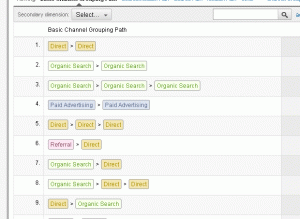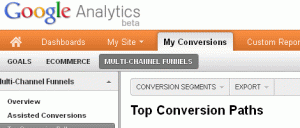In part one of The ABCs of Ecommerce Success I outlined some important thinking which I consider makes up some very basic foundational elements of a successful ecommerce business. I talked about how many stores adopt a ‘traffic’, ‘product’, ‘website’ (TPW) mentality and how falling into this trap can often end up hurting your business before it ever has a chance.
For those that may not have read that article, my ‘traffic’, ‘product’, ‘website’ mentality proposes that stores believe all they need is traffic and if they drive enough traffic to their site, their product will sell itself. They believe the website is simply the channel by which that transaction can be made possible—nothing more.
I proposed this thinking wrong and said that presentation was far more important than any other factor—at least initially. Everyone has heard that ‘image is everything’, and that saying couldn’t hold more true than on the internet where the primary means a potential customers users to gather information in an effort to make a buying decision begins with their eyes.
Yes, with the advent of video we can stretch this. But the primary way people determine if they are interested or not in a product / company is with their eyes. Pictures, copy, layout, pricing, it all has to first pass by the eye before it ever reaches another part of the potential consumer.
So if the way to a consumer is through their eyes, then why do I find so many stores trying to sell their products with unusable, outdated, and often poorly designed sites? It makes no sense that these companies feel all they need is more traffic and their sales will increase—a false assumption that should now make perfect sense why.
My proposition is that the way to approach it if you want to find success should be thinking in terms of ‘website’, ‘product’, ‘traffic’ (WPT)—with traffic coming in last on the list. First you refine the look of the website, you refine the presentation of the product, and then you drive the traffic. With this approach, providing you let marketing and customers drive design, you should end up with a foundation that is built upon the proper principles and which is ready to convert the traffic you are driving to it.
This is all well and good, but many are going to ask, great, what happens once they get to your website? “I realize the thinking and it makes sense, but how do we apply that to the site itself? Where do we start with our efforts to get the biggest bang for out buck?”
This is a great question, and is the primary question I’ll answer using the same conceptual approach as the ‘WPT’ illustration.
When a user arrives at a website they follow what should be a pre-defined path based on their demographic profile. While traveling the path they go through a series of pages until they reach the end of their journey and either make a decision to buy, or leave. The path they travel should be well planted with information that enables them to complete what are called micro actions all leading up to the actual sale or macro action.
Understanding that a site is compromised of both micro and macro actions on multiple levels and at varying points, as well as understanding the role of each will help you identify the answer to your question “where do I start?”
In working with store owners / operators, I teach them to think in terms of each page on a website having one primary job (yet multiple sub jobs—these are the micro actions of the page itself.) Much like building a house in that each element has a job to perform which is often dependant on another for the completed project to work as it was intended (the macro action is completed.)
In other words, you don’t start building a house by working on the roof first. You need supporting structure to hold that roof if it is to perform its job as expected. Likewise you don’t begin building the walls without some type of support to put them on first (i.e. the cement foundation.) Each portion of the house has its individual role (job) and they all perform together to accomplish the primary objective. But without these items all performed in the proper order, the entire structure is in jeopardy of failing.
A site should be looked at no differently. When attempting to make incremental design changes in an effort to boost productivity of the site, you need to first determine and understand what areas of the supporting structure are weakest if you are to strengthen the complete package. There is really only one place you should get this data from, and that is within your analytics reporting. Objective data doesn’t tell lies, that is, assuming you have your analytics installed correctly of course.
Take this fairly typical path as one example. Mind you that the path could start at a product or category page if traffic enters there however, the path I presented here is a fairly common path that many visitors follow and thus we’ll use it for illustrative purposes.
The path we’ll examine for increasing productivity is that for the visitor(s) who enter at the home page, proceed to the category page, proceed to the product page, and then proceed to the checkout process. This is a very high level depiction and again, is for simple illustrative purposes in helping you understand where and why you should begin your efforts at one spot versus another.
Taking this path into account let’s apply some analytic figures to it. For this example let’s say that the overall website bounce rate is 85%, the exit rate at the category page is 30%, the exit rate at the product page is 25%, and the shopping cart abandonment during the checkout process is 50%.
Many stores I find would dive right into the shopping cart abandonment as the problem and thus focus efforts there first—not a bad idea for picking up quick sales, however; in our scenario this would not be a good starting point for increasing overall site productivity. In fact, more often than not, stores in this situation who I find focus their efforts on the shopping cart abandonment as the sole problem end up discouraged to find that although they have streamlined the checkout, the sales have not increased to the levels they expected.
The lack of increase makes sense if you consider ‘building the house the proper way.’
In other words, our problem of an 85% bounce rate is far more of an issue than the checkout abandonment at the moment. If visitors who arrive at our site leave at the same point they arrive without going any further (in our example the home page) then focusing efforts deeper in the process (i.e. the checkout) is not going to increase sales. Putting it bluntly, if the majority of visitors are not making it beyond the home page, then they aren’t even getting to the checkout process and thus focusing efforts there first isn’t going to strengthen the ultimate outcome.
Likewise, making alterations to the product level page without consideration given to the category page will do you no good. You must first concentrate your efforts to those areas of the funnel which are preventing your visitors from completing the micro actions required to ultimately achieve the macro action. Let your analytics be your guide in determining where to focus efforts at any given moment.
Success does not come from making random changes and taking estimated shots in the dark. Success comes from making incremental changes based on measurable and objective results then having the ability to weight the impact those changes have in reaching your goal.

